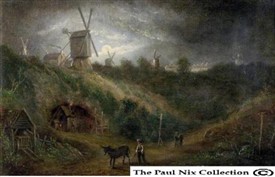The Windmills by The Forest

Old Ropewalk. Foot of Gallows Hill by Thomas Moore 1848
The Paul Nix Collection
By Joseph Earp
The windmills that once stood on the ridge of the Forest were nearly all post-mills, of wooden construction, comparatively easy to dismantle and cart to another site. Some where brought in from elsewhere, some were moved away so the numbers could change over time. When the Forest ridge was made part of the allotted recreation ground by the 1845 Inclosure Act, all the windmills had to be removed, except the only one built of brick which was on the other side of the road on private land. At that time there were 13 mills on the ridge.
The Mayor and Council, as Lord of the Manor, tried to control the mills, and the encroachment of their gardens and houses on the Forest, ‘on which the Burgesses and Inhabitants of this Town enjoy an unquestionable right of commonage’ and they insisted in 1797 that the fences were removed and the gardens laid open to the Forest. This did not apply to the fences round the mills themselves, ‘for the purpose of preventing anyone’s approach within the Range of the Mill Sails’. However, this precaution was not always taken, it seems.
Weekly Guardian, 1928.
‘As we used to play about these mills, not preventing the danger we were in as the sails whirled round, until one struck a playmate and killed him, much to our grief and dismay’.
The mills were often owned and occupied by bakers, as part of their businesses, but some were owned by one man to be rented out to others. Some millers seem to have moved from one mill to another, maybe because their contract was up, or because a better one became vacant. Immediately after the passing of the act in 1845 there was no great pleasure to remove the mills, but they all knew that they had to set about finding new sites, or selling them.
Below are descriptions, information of some of the mills and what became of them:
(1.) The only brick tower-mill there, in a field on the south side of the road, at the top end of Larkdale. Occupied by Richard Annibal, baker in Long Row, Nottingham, and then Mr Smith, baker of Albert Street, Nottingham, who converted it to steam power. Burnt down 1858.
(2.) Known as Dame Moss’s Mill, it had a house within its enclosure and was not far from Larkdale. It was owned by William Brewill, who let it to Mr Sharp, and William Smith. It was pulled down and moved to Kegworth, Nottinghamshire.
(3.) Near the south west corner of Mount Hooton Road. Owned by a Mr Barradell. Demolished and rebuilt in Redmile, Vale of Belvoir.
(4.) Was opposite the post office on Forest Road. Known as Bailey’s Mill. There was a house in the Mill grounds and another was later built on the old mill mound. One of the occupants had his clothes caught in machinery and subsequently died. The mill house is till there on Forest Road East.
(5.) Owned and occupied by a Mr Sharp, it was attacked by rioters in 1831, doing quite a lot of damage. After the Inclosure act it was moved to Farndon, Nottinghamshire, where it was known as the Nottingham Mill.
(6.) In the now Church Rock Cemetery stood a mill owned by a Mr Samuel Toyne, baker at Back Lane (Wollaton Street). Moved to Kimberley, Nottinghamshire. Burnt down in 1862.
It is reported that seven of the Forest Mills turned clockwise and six anti clockwise, giving rise to the joke that they we ‘grinding’ and ‘ungrinding‘.
The natural hill that the Forest rises to gave a unique and ideal location to place the mills. Eventually with the Inclosure act of 1845 the Forest as we know it today was created and the Widmills became a bygone memory of yesteryear.
Article by Joe Earp and Iris Tansley
The New Nottingham Hidden History Team